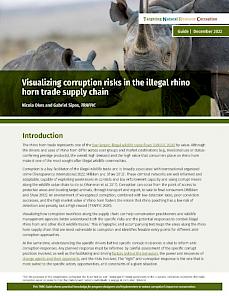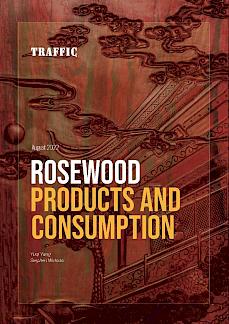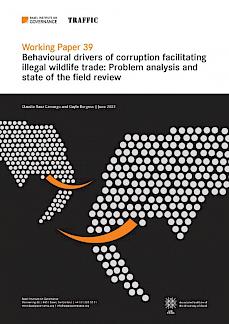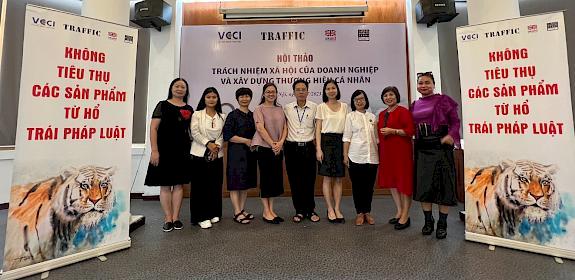
A rhino horn consumer in Hanoi, Vietnam, shows off horn she purchased to treat a tumor © Robert Patterson / WWF
i
a background to the issue
The illegal killing of African rhinos was a relatively minor occurrence until the early 2000s, at which point increasing consumer demand from Asia began to drive rapidly increasing poaching levels.
Although rhino horn is made up of keratin–the same substance as human hair and nails–there is a widespread belief in Asia embedded in cultural and social norms that rhino horn possesses various curative and spiritual properties. This makes developing impactful behavioural change responses an ongoing conservation challenge.
at least three African rhinos
poached every day 2013–2017

Identifying key rhino horn consumers and the motivations behind their consumption enables us to develop messages most likely to resonate with target audiences
Trinh Nguyen, Senior Programme Officer
behavioural change in Viet Nam
Although early indicators point towards China emerging as the leading market for illegal rhino horn, Viet Nam continues to be a major consumer of rhino horn products.
Kickstarted by urban myths concerning its perceived health and curative benefits, rhino horn has also since become a sought after status symbol among Viet Nam's burgeoning wealthy middle classes.
Rhino horn grinding bowls in Hanoi, Viet Nam © Robert Patterson / WWF
i
the Chi Initiative
The Chi Initiative is a collaborative social marketing project that aims to reduce demand for rhino horn among Mr. L consumers. The initiative is based on the Vietnamese concept of “Chi” or “Strength of Will,” and reminds consumers that their success and prosperity come from their hard work, not from illegal wildlife products.
The Chi Initiative creates communications materials and interventions in partnership with the target audience to ensure their resonance. The project has garnered international recognition as a model for how SBCC can be applied to conservation by harnessing the potential of advanced consumer profiling and behavioural modelling techniques to guide the development of demand reduction initiatives. TRAFFIC has used the Chi Initiative’s behavioural change framework as a basis to drive forward SBCC work in Viet Nam on other species. The programme began in 2014 and is now in its third phase as part of the USAID Wildlife Asia activity.
who are the consumers?
The identification and psychological, cultural, and social profiling of core consumer groups is a key step in developing appropriate behavioural change messaging.
A combination of market surveys, anonymous questionnaires and profiling techniques have enabled us to develop a detailed picture of the archetypal rhino horn consumer in Viet Nam. For the purposes of helping to shape SBCC initiatives, his name is "Mr. L."
"MR. L" CONSUMER PROFILE:
- Aged 35–55
- Married with Children
- Lives in Hanoi or Ho Chi Minh City
- Prioritises a successful career + social status
- Wants to be seen as a leader
- Influenced by social + business contacts
a strategic approach
The Chi Initiative, in addition to guiding wider SBCC projects, is split into phases, each targeting consumer groups with different types of messages and messengers.
Examples of strategic Chi messaging techniques have included facilitating face-to-face engagement by high-profile "Agents of Change" within celebrity and corporate spheres as well as the development and placement of targeted SBCC adverts in business lounges, sport centres and inside corporate publications.
An example of a billboard advert developed under Chi Phase I
i
engaging civil society and the private sector
The Chi Initiative has strengthened its connection to the target audience by cultivating relationships with individuals and groups identified through research as having the greatest influence on Mr L’s behaviour, such as Vietnamese civil society organisations (CSOs), business leaders, and government figures. The initiative has given partners the tools necessary to deliver meaningful behavioural change interventions and effectively spread SBCC messaging throughout their networks.
The Chi Initiative has worked with key partners, such as the Vietnam Chamber of Commerce and Industry and the Vietnam Automobile Transport Association, to promote the adoption of wildlife-focused corporate social responsibility (CSR) by Vietnamese businesses. Together we have trained thousands of Vietnamese businesspeople on how to mitigate legal risks and increase revenues through targeted CSR activities.
To facilitate the uptake of wildlife-focused CSR, the Chi Initiative created this CSR guidebook in partnership with CSO members and other business specialists. The book includes step-by-step guidance on implementing environmental policies, as well as case studies that demonstrate the link between CSR and increased competitiveness.
75% increase
between 2012–2017 in survey respondents who expressed commitments to not use or trade in rhino horn
250,000+
people have been exposed to anti-trafficking SBCC messaging through workshops and communications campaigns
40
key social influencers have taken a public stance against illegal wildlife consumption
related materials to SBCC on rhino horn
explore the latest news, reports and materials concerning our work to reduce the motivation for the consumption of rhino horn in Asia
related reports to RHINO HORN and SBCC
TRAFFIC is a leading voice on SBCC methodology and measurement. Explore our latest reports related to SBCC and rhino horn our visit our publication library for the full TRAFFIC archive.






